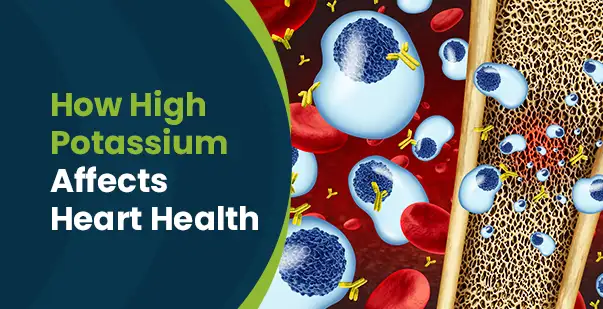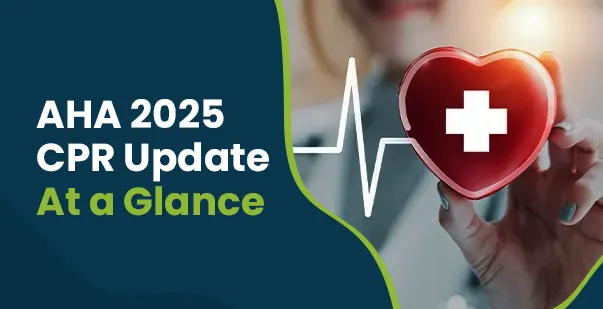Potassium is an important mineral and electrolyte that helps your muscles move, your nerves work properly, and your heartbeat stay steady. About 98% of the potassium is found inside your cells, with only a trace level in your blood. The kidneys regulate this balance by filtering out excess potassium through urine so it’s within a safe limit. Serum potassium is tightly regulated because even slight fluctuations can cause severe cardiac symptoms.
But when the kidneys aren’t working well, or potassium builds up faster than the body can remove it, hyperkalemia occurs. This condition can disrupt the electrical signals that keep your heart beating in a regular rhythm. In severe cases, hyperkalemia may cause life-threatening arrhythmias, heart block, or cardiac arrest. So, read on to learn the relation between high potassium and heart health, what to watch out for, treatment, and management strategies.
What Happens When Potassium Gets Too High?
Hyperkalemia is a condition where the level of potassium in your blood is too high. The body normally keeps potassium levels between 3.5 to 5.0 milliequivalents per liter (mEq/L). When levels go above 5.0 mEq/L, it’s called hyperkalemia. Mild hyperkalemia may not cause symptoms, but when potassium rises too high, it can lead to dangerous heart rhythm problems and even sudden cardiac arrest. It slows conduction, widens QRS complexes, causes peaked T waves, flattened P waves, and an eventual sine wave pattern on an EKG as the severity increases. If the treatment is not started on time, this can quickly progress to ventricular fibrillation or asystole (cardiac standstill).
The heart’s electrical system relies on potassium to manage repolarization, the part of each heartbeat when the heart resets for the next contraction. Too much potassium floods this system, causing erratic signals that the heart cannot properly respond to. In the United States, studies estimate that up to 10% of hospitalized patients may experience hyperkalemia. The risk is significantly higher in those with chronic kidney disease (CKD), where potassium excretion is impaired. One primary-source study found a 9.6% prevalence across all CKD patients, rising to 17.3% in stage 5 (pre-dialysis). In advanced CKD, including dialysis patients, prevalence can reach as high as 40%.
What Signs To Look for High Potassium Levels?
Hyperkalemia usually has no symptoms in the initial stages. But as the level of potassium increases in blood, it begins to influence muscles, nerves, and worst of all, the heart. The following are the symptoms to observe, along with the reasons why they occur:
Muscle Weakness or Fatigue
When potassium accumulates, it disrupts the signals that assist your muscles in contraction and relaxation. Your arms or legs can feel heavy, tired, or weak as a result. You may be unable to walk, lift objects, or even roll over in bed without getting extremely fatigued. This happens in more moderate to severe hyperkalemia, not the early/mild stages.
Tingling or Numbness (Pins and Needles)
While not as common as muscle weakness, some people may experience tingling, numbness, or a buzzing sensation, often in the hands, feet, or around the mouth. Disruptions in nerve signaling cause these sensations, sometimes linked to changes in potassium levels. However, this is a less frequent symptom. Always pay closer attention to more definitive signs like muscle weakness, vision changes, or breathing difficulty.
Muscle Cramps or Pain
Your muscles require a balanced amount of potassium to function correctly. When there is excess, the impulses are erratic, which could lead to sudden cramps or excruciating muscle tightening. It could occur at rest, exercise, or even during sleep.
Nausea or Vomiting
An excess of potassium irritates the digestive tract and disturbs the smooth muscle function of your stomach. This can cause a queasy feeling in your stomach, a need to vomit, or vomiting itself, particularly when potassium increases rapidly.
Irregular Heartbeat or Palpitations
Potassium regulates your heart’s rhythm. When its levels are too high, it can disrupt the way the heart’s electrical system functions, causing skipped beats, fluttering in the chest, or a rapid heartbeat. Severe cases can lead to life-threatening arrhythmias if not treated immediately.
Shortness of Breath
When hyperkalemia is severe, it can cause the breathing muscles to weaken. In addition, if the heart is not pumping because of abnormal rhythms, the lungs won’t receive enough oxygen-carrying blood, and one would breathe rapidly or shallowly.
Chest Pain
If potassium throws off the heart’s electrical signals too severely, it may lower circulation to the heart muscle. This can bring on chest tightness or discomfort. Sometimes, it may be an indication of a heart attack or other cardiac emergency. However, chest pain due to hyperkalemia is rare unless arrhythmias are impairing cardiac output.
Paralysis or Inability to Move
Very high potassium levels can result in flaccid paralysis when muscles no longer respond. This is when nerve and muscle communication fail. It typically begins with the legs and can ascend, becoming dangerous if the breathing muscles are involved. This resembles ascending flaccid paralysis seen in Guillain-Barré, so diagnostic confusion can occur.
Slow or Weak Pulse
When potassium levels severely impact the heart’s ability to contract, it may slow the pulse or make it faint. This weak pulse means the heart isn’t pumping enough blood, which can lead to dizziness, fainting, or even cardiac arrest.
Sudden Collapse or Fainting
If potassium peaks acutely, it can precipitate life-threatening arrhythmias that lead to loss of consciousness or syncope. This is a medical emergency because it can be an indication of cardiac stoppage (asystole) or extreme electrical instability of the heart.
Since hyperkalemia symptoms are also common in other health problems, a blood test is the only way to confirm high potassium levels.
What Causes Potassium Levels to Become Too High?
In people with chronic kidney disease (CKD), the risk is much higher; over 50% may develop high potassium at some point. It can happen for several reasons. However, the most common causes are discussed as follows:
- Kidney Problems
The kidneys help remove extra potassium from the body. If the kidneys are not working properly, like in chronic kidney disease (CKD), potassium builds up in the blood. Studies show hyperkalemia affects 14–20% of CKD patients and around 9.6% of those not yet on dialysis. This is the most common cause of hyperkalemia, as the body cannot get rid of potassium through urine effectively.
- Certain Medications
Some medicines can increase potassium levels by affecting how the kidneys handle it. These include ACE inhibitors, RAAS inhibitors, angiotensin receptor blockers (ARBs), potassium-sparing diuretics, and NSAIDs like ibuprofen. In CKD trials, using RAAS inhibitors led to hyperkalemia in 38.4% of patients (>5 mmol/L) and 10.8% at >5.5 mmol/L. People taking these medications should get their blood tested regularly, especially if they have kidney disease or other risk factors.
- Too Much Potassium in the Diet
Foods high in potassium, like bananas, potatoes, and oranges, can raise potassium levels if the kidneys aren’t filtering well. When the kidneys can’t remove extra potassium, even normal amounts in food may cause hyperkalemia. A low-potassium diet may be recommended.
- Uncontrolled Diabetes
In uncontrolled diabetes, high blood sugar levels (hyperglycemia) affect how potassium moves between blood and cells. Insulin helps shift potassium from your blood into your cells. When insulin is low or not working properly, potassium stays in the blood, leading to high potassium levels or hyperkalemia.
This can occur in two key scenarios:
- Type 1 diabetics in diabetic ketoacidosis (DKA), where insulin is severely deficient
- Type 2 diabetics with significant insulin resistance, where insulin is present but not effective enough to regulate potassium movement
Both conditions can lead to dangerously high potassium levels if not treated promptly.
- Tissue Damage
When large numbers of cells break down rapidly, potassium, normally stored inside cells, leaks into the bloodstream, leading to sudden and severe hyperkalemia. This can occur in several medical situations:
- Rhabdomyolysis, where muscle tissue breaks down due to crush injuries, prolonged seizures, extreme physical exertion, or severe burns
- Tumor lysis syndrome (TLS), which often develops after chemotherapy in patients with leukemia or lymphoma, occurs when the rapid destruction of cancer cells releases large amounts of potassium, phosphate, and other cellular contents into the blood.
Both conditions require prompt recognition and treatment, as the surge in potassium can quickly disrupt heart rhythm and other critical functions.
- Adrenal Gland Disorders
The adrenal glands produce a hormone called aldosterone, which helps control potassium levels. In disorders like Addison’s disease, aldosterone production is too low, and the kidneys cannot remove enough potassium. This hormonal imbalance can cause hyperkalemia, along with low blood pressure and fatigue.
How Can High Potassium Levels Affect The Heart?
The heart relies on a steady level of potassium to beat normally. If potassium levels rise too much, the heart’s rhythm can change. The following are the consequences if your potassium levels remain too high for a longer duration:
- Slow Heart Rate (Bradycardia)
High potassium levels slow down the electrical signals in the heart by affecting the sinoatrial (SA) node, which is the heart’s natural pacemaker. When potassium is too high, the SA node fires less often, leading to bradycardia, a slower-than-normal heart rate that may cause fatigue, dizziness, or fainting.
- Irregular Heartbeat (Arrhythmia)
Excess potassium interferes with the movement of ions across heart cells, disrupting the normal rhythm. This can cause arrhythmias, where the heart beats too fast, too slow, or irregularly. Severe arrhythmias reduce how well blood is pumped, increasing the risk of complications like stroke or sudden cardiac arrest. In acute heart attack cases, those with high potassium had more than double the risk of dangerous ventricular arrhythmias (RR 2.33; 95% CI 1.60–3.38)
- Heart Palpitations
When potassium levels are elevated, the heart’s electrical activity becomes unstable. This instability can cause palpitations, where the person feels a fluttering, pounding, or skipped heartbeat. These sensations are due to rapid or irregular electrical impulses in the atria or ventricles of the heart.
- Sudden Cardiac Arrest
A Danish study of hospitalized patients found that severe hyperkalemia (K⁺ > 6.5 mEq/L) doubles the risk of in-hospital cardiac arrest compared to those with normal levels. In extreme cases, dangerously high potassium levels can cause a complete breakdown of the heart’s electrical system. This can lead to a sine wave pattern on ECG and eventually asystole or ventricular fibrillation, both of which stop the heart from pumping, resulting in sudden cardiac arrest if not treated immediately.
- Dizziness and Weakness
Disrupted potassium balance weakens the heart’s ability to pump blood efficiently. Reduced blood flow to the brain and muscles leads to symptoms like dizziness, lightheadedness, and muscle weakness. This occurs because the altered membrane potential in cells affects both heart function and muscle activity throughout the body.
Read More: Can An Excess of Potassium Cause Cardiac Arrest?
How Does a Doctor Diagnose Hyperkalemia?
The effects of high potassium on the heart and the rest of the body are diagnosed through a blood test that measures the level of potassium in your bloodstream. If the result shows a potassium level above 5.0 milliequivalents per liter (mEq/L), it may indicate hyperkalemia. If levels are high, your doctor may do additional tests to find the cause, such as checking kidney function or reviewing your medications. A common false high can also result from serum hemolysis due to poor blood draw technique. In such cases, a repeat test is often needed to confirm accuracy.
An important tool to assess how high potassium affects the heart is an electrocardiogram (ECG or EKG). This test records the heart’s electrical activity and helps detect rhythm problems caused by high potassium. Hyperkalemia ECG changes can include:
- Tall, peaked T-waves (early warning sign)
- Flattened or missing P-waves
- Widened QRS complex
- Sine wave pattern (very dangerous and may lead to cardiac arrest)
These signs help doctors decide how serious the condition is and whether emergency treatment is needed to protect the heart.
Fig. ECG Snapshot: What High Potassium Looks Like
| Danger Zone: When to Seek Emergency HelpChest pain or pressureFainting or near faintingSlow, weak, or irregular pulseRecent changes in medications or diet |
What Treatments Can Help Lower High Potassium?
Treatment depends on how high the potassium is and what’s causing it. Do the following to manage high potassium in heart patients:
- Diet Changes
In mild hyperkalemia, reducing potassium-rich foods like bananas, oranges, spinach, and potatoes can help lower potassium levels. This is especially important for people with chronic kidney disease, where the body cannot get rid of extra potassium through urine. A low-potassium diet supports safer blood potassium levels.
- Stopping or Changing Medications
Some medications raise potassium levels by affecting how the kidneys handle it. Doctors may stop or adjust drugs like ACE inhibitors, ARBs, potassium-sparing diuretics, or NSAIDs. This helps reduce potassium build-up in the blood and can reduce potassium-induced cardiac complications.
- Diuretics
Diuretics, or “water pills,” help the kidneys remove excess potassium by increasing urine production. Loop diuretics like furosemide are commonly used. These drugs are useful when the kidneys still function and can respond to medication by clearing potassium through the urinary system. In ESRD (End-Stage Renal Disease) patients, this doesn’t work.
- Calcium Gluconate
Calcium gluconate is given through an IV to protect the heart from the harmful effects of high potassium. It doesn’t lower potassium but stabilizes the cardiac membrane to prevent dangerous heart rhythms. Its effect is quick but short-lasting, so it’s often used in emergencies. Clinical guidelines recommend IV calcium for K⁺ > 6.5 mmol/L or when ECG changes are present.
- Insulin with Glucose
Insulin helps move potassium from the blood into the body’s cells. To prevent low blood sugar, insulin is given along with glucose. This is one of the fastest ways to lower blood potassium levels during moderate to severe hyperkalemia temporarily.
However, insulin therapy isn’t without risks, especially in patients with kidney problems. A 2024 retrospective U.S. cohort study found that 18% of patients with reduced kidney function developed hypoglycemia after insulin-glucose treatment for hyperkalemia. This risk was similar in both hemodialysis-dependent and non-dependent patients.
- Sodium Bicarbonate
Sodium bicarbonate is used if the person has metabolic acidosis, a condition where blood becomes too acidic. It raises blood pH and helps move potassium back into cells. This treatment is especially helpful in patients with both high potassium and low blood pH levels.
- Beta-Agonists (Like Albuterol)
Beta-agonists like albuterol, used in inhalers for asthma, can also lower potassium levels. They work by stimulating beta-2 receptors, which push potassium into cells. This is usually a temporary treatment and may be used along with insulin and other medications during emergencies.
- Potassium Binders
Potassium binders like sodium polystyrene sulfonate (Kayexalate) or patiromer help remove potassium through the digestive system. The OPAL-HK trial showed that patiromer lowered potassium by an average of 1.01 ± 0.03 mmol/L in four weeks, with 76% reaching the normal range. These drugs bind to potassium in the intestines and carry it out through the stool. They are slower-acting but useful for long-term management in people with chronic hyperkalemia.
Note: Kayexalate has fallen out of favor due to safety concerns. The FDA has issued a black box warning for Kayexalate. It highlights the risk of colonic necrosis, especially in patients with recent abdominal surgery, bowel obstruction, or conditions like ileus. The American Heart Association (AHA) and several nephrology guidelines now recommend limiting its use, particularly when safer alternatives like patiromer or sodium zirconium cyclosilicate are available.
- Dialysis
In patients with kidney failure or dangerously high potassium levels, dialysis is the fastest and most effective way to remove potassium. It filters the blood directly, removing extra potassium and waste. This is a life-saving treatment for people who cannot lower their potassium levels by other methods. Emergency dialysis is typically indicated when potassium levels are above 6.5 mEq/L, especially if there are EKG changes or if the condition is refractory to medical treatment.
How to Deal With a Hyperkalemia Emergency?
In emergencies, where potassium levels are dangerously high (usually above 6.5 mEq/L) or when an ECG shows serious changes, quick treatment is essential to prevent cardiac arrest. You should call 911 immediately and follow the steps listed below for hyperkalemia emergency management:
- Stabilize the Heart: Administer IV calcium gluconate to protect the heart by stabilizing the cardiac membrane.
- Shift Potassium into Cells (Insulin + Glucose): Give insulin with glucose to quickly move potassium into cells and lower blood levels.
- Use Beta-Agonists: Administer beta-agonists like albuterol to shift potassium into cells through beta-2 receptor activation.
- Correct Acidosis with Sodium Bicarbonate: Use sodium bicarbonate to raise blood pH and push potassium into cells in cases of metabolic acidosis.
- Remove Potassium with Diuretics: Give loop diuretics like furosemide to enhance urinary potassium excretion if kidney function allows.
- Bind Potassium in the Gut: Use potassium binders such as Kayexalate or patiromer to remove potassium through the digestive system.
- Perform Dialysis if Needed: Initiate dialysis for rapid potassium removal in cases of kidney failure or severe hyperkalemia.
- Monitor Continuously: Perform frequent ECGs and blood tests to monitor potassium levels and cardiac rhythm during treatment. If cardiac arrest occurs, begin CPR immediately and use an AED if available until emergency responders arrive.
Managing High Potassium to Protect Your Heart!
Potassium and heart health are directly related. It is a key mineral that keeps your muscles and heart working properly, but too much of it can be dangerous. When your potassium levels get too high, a condition called hyperkalemia can occur. It can affect your heartbeat and even lead to serious heart problems like arrhythmias or cardiac arrest. That’s why it’s important to know the signs, such as weakness, irregular heartbeat, or chest pain, and get a blood test if you’re at risk. Luckily, some treatments work, like diet changes, medications, and even dialysis in severe cases.
Since high potassium can lead to sudden heart emergencies, knowing how to respond quickly matters. If someone near you collapses or stops breathing, every second counts. That’s why many health professionals recommend learning CPR or AED (automated external defibrillator) via an online course. It’s a simple skill that could help you save a life, possibly even your own or a loved one’s.









